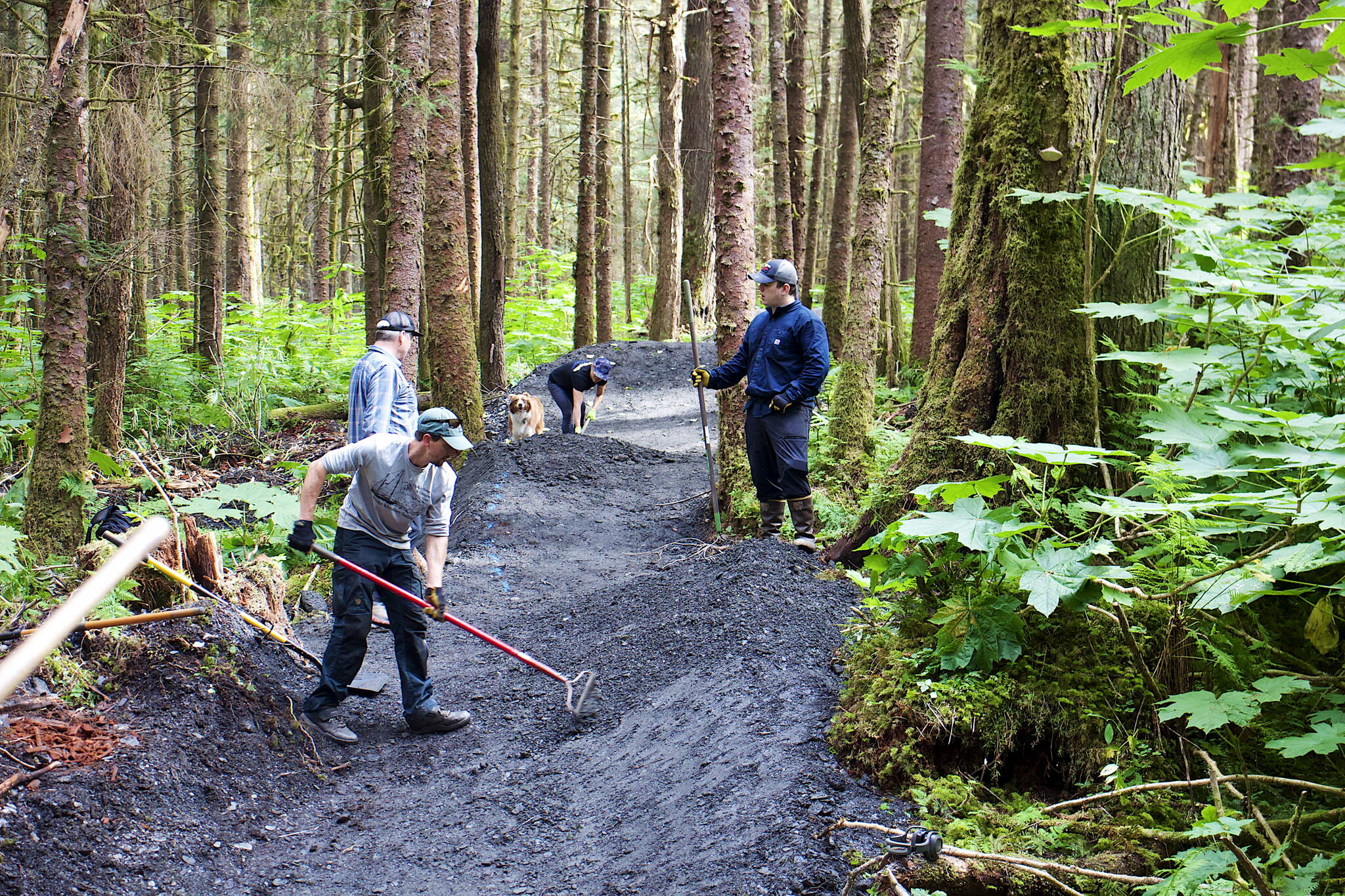Paul Paramore, 36, a lifelong Juneau resident and a mountain biking enthusiast since childhood, said he generally heads to the Lower 48 for serious trail action. But while walking a nearly-complete path at the new Thunder Mountain Bike Park on Saturday, he said it appears Juneau may now have something to fulfill that craving.
“Nobody from Juneau can jump because nobody had properly made jumps,” he said while examining the trail and praising about a dozen volunteers completing final work in it, referring to existing paths. But the new 1,500-foot-long intermediate-level trail has jumps and turns that are made correctly, and “I was just impressed with how hard (the surface) is already.”
The trail, along with a 1,000-foot-long beginner’s trail, is expected to be ready to ride early next week, said Reid Harris, president of the Juneau Mountain Bike Alliance, which is collaborating with Trail Mix Inc. and other local entities to build the new bike park mostly with the labor of volunteers. The park near Sítʼ Eetí Shaanáx̱ – Glacier Valley Elementary School is located on about 50 acres of city-owned forest and already has two existing trails, and is expected to eventually have four new trails between about 1,000 and 2,000 feet in length.
Harris said while Juneau has numerous bike trails, most are in the vicinity of downtown and Douglas Island, and the current park offers a design and features different from existing local trails.
“We didn’t want to just like come in with a bulldozer, kind of a big straight slash through the trees, and make it 10 feet wide,” he said. “It’s more like the trail has a six-foot-wide tread. It’s very serpentine. It flows around nicely. It’s got these beautiful build features and jumps that are beginner- and intermediate-friendly, and also appealing for advanced riders.”
The quality of the nearly finished trails was praised by Reid Graham, 13, a Colorado resident who spends half of his summers with his dad in Juneau, and frequently rides existing trails throughout town and showed up to help with Saturday’s volunteer work.
“Those jumps are looking a lot better than the Eaglecrest jumps,” he said, referring to a trail at the city-owned ski area. “The Eaglecrest jumps are gravel, so if you crash you’re kind of screwed.”
But the rugged-ride paths at Thunder Mountain Bike Park started as just plain rugged-to-navigate second-growth forest a few months ago.
“A devil’s club jungle,” said Jim Papoi, a volunteer helping build a jump.
Clearing a path through the trees – standing and fallen – and undergrowth started with a planning process that began well before the first foliage was cleared, said Gary Paasch, owner of a Washington-based company that specializes in building such trails. He studied a topography map and other information, sketching out preliminary lines for possible trails.
Afterward he and other project leaders bushwhacked through the entire stretch of dense forest four or five times planning the route of the trail.
“We took a survey of what land we’re working with, what features are naturally here and then talked about possible future trails, and the possibility of using this space to get more trails,” he said. “So that kind of determined that ‘OK, here are a few possible lines that could be built at some point.’ And for the skill level and the type of jumpy trail that we’re trying to find, this line provides a good grade and allows us to really kind of mold the terrain, and get all that we possibly can out of a space that we have.”
The beginner’s trail was largely planned out by Jack Kreinheder, a board member of both the Juneau Mountain Bike Alliance and Trail Mix, who said the 1,000 feet of trail features 22 corners, along with berms and rollers.
“So you’re turning non-stop, basically,” he said, adding “this is designed to be fun for bikers of all levels.”
Materials have come from multiple public and private sources, including wood donated by Juneau’s municipal government and a company in Hoonah, Harris said. The city also provided an excavator to help remove the most difficult obstacles such as stumps and roots of fallen trees, although an effort was made to preserve trees still living.
“We found this phenomenal old-growth hemlock tree somewhere further down and the best place to have the trail would have been right through the middle of that tree,” he said. “But we’re like ‘we’re not doing that.’”
Paasch said he was hoping by the end of Saturday the trail he was working on would be ready for the official testing process.
“Grabbing my bike and hitting the jump for the first time,” he said. “It’s my favorite part of this whole process.”
• Contact Mark Sabbatini at mark.sabbatini@juneauempire.com or (907) 957-2306.

